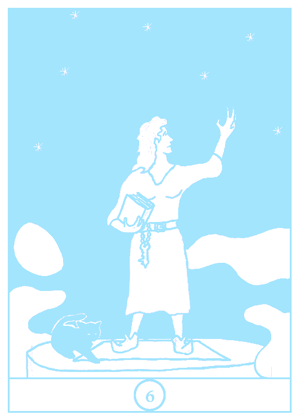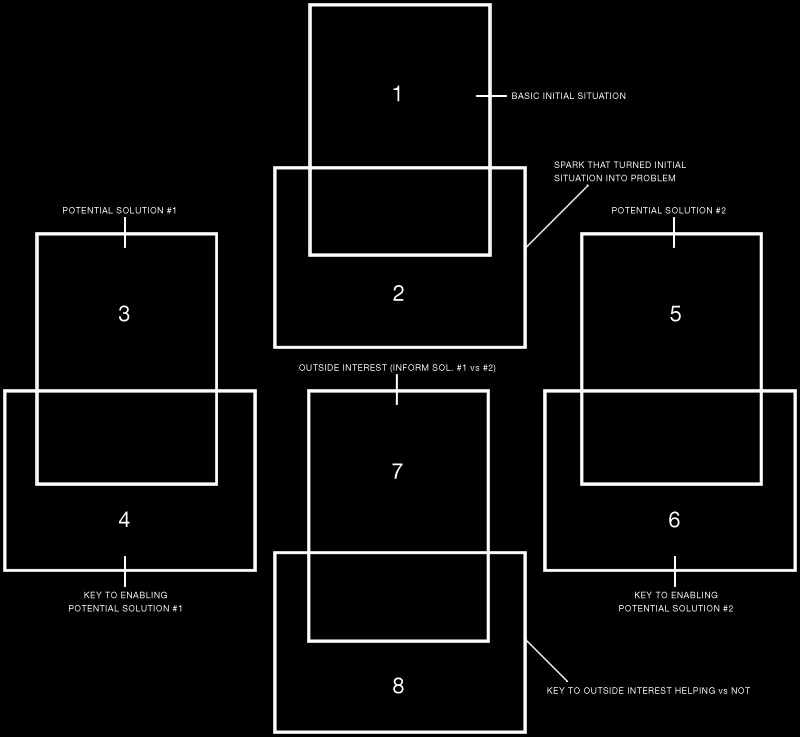Reading the Cards
Each card is intended to have a unique general theme, as well as a variety of individual elements. When looking to a card for inspiration, there is no rule on what to focus on. It will vary depending on what sort of inspiration you need.
Let's look at Card 6. Possible uses: 
Situation: stargazing from on high
Instigator: a low gibbous moon
Solution to problem: a physical key
Outside interest: an ambitious young man
Key to that interest: a cat
Adding it up: The village's problem began when their famed astronomers caught something in a telescope lens. They were used to examining the moon, but this time the moonlight passed through a specific spot of demonic corruption, which took form when magnified by the lens. None of the astronomers knew exactly what happened, but what little they do know has been covered up by their ambitious young leader. This man is secretive, but will trade any info for the return of his lost pet cat. He will reveal that the demon's arrival left a strange mark on the lens, in a shape that the PCs will recognize from the strange key they discovered elsewhere in the village. (In practice, you'll be drawing scenario elements from multiple cards, not from one. This was just to illustrate the process of fitting some pieces together.)
Step 1: Pick a card for each of the 8 positions in the spread
Pick without replacement. Each of the 8 positions must be occupied by a different card. (Visual summary below.) Write these down, using whatever shorthand you want to denote cards. Note there are two cards numbered 15.
Example: "Position 1: 15-red" or "1: king"
Position 1: The initial situation, before it completely became the current problem.
Position 2: The spark that turned the initial situation into the current problem.
If this already gives you an idea for a problem, jot down your idea.
Position 3: Possible Solution #1 (PS1). How the problem might be solved, or learned more about.
Position 4: Key to PS1. What the characters need to do in order to discover, access, and/or make use of PS1.
If this already gives you an idea for a solution process, jot down your idea.
Position 5: Possible Solution #2 (PS2). How the problem might be solved, or learned more about.
Position 6: Key to PS2. What the characters need to do in order to discover, access, and/or make use of PS2.
If this already gives you an idea for a solution process, jot down your idea.
Position 7: Outside interest who might be a help or hindrance. This must be an agent who is not inherently part of the source of the problem. The outside interest needs to have their own goals for the situation; ideally these could be aligned with or opposed to the PCs, depending on the specifics of the PCs' actions.
Position 8: Key to the outside interest. What the characters need to do in order to glean further info about the solution options from the outside interest. The outside interest has info which favors one possible solution (PS1 or PS2) over the other. This info may be anything from "I know how to solve this, convince me to tell you," to "Does this red mud on my boot mean anything?"
The steps below don't deal with the outside interest any further, so feel free to flesh this out as much as you are inspired to do at this time. You should also feel free to skip it for now, merely noting the cards and coming back to do this last.
Step 2: Define the scenario's problem
Problem Source: Looking at the cards you drew for positions 1 & 2, look for ominous or creepy combinations. Pick two elements that connect in a way that gives you evil thoughts. Figure out what kind of demonic influence is at work -- a monster, a spell, a madman, orcs, etc.
Evil Mission: Pick two cards, and do the same thing you did for the problem source. You can pick with or without replacement form the deck; or, you can skip the cards completely if you don't need inspiration. All you need to come up with is the evil thing's goal.
Evil Methods: How does the evil thing go about its goal? You may have already covered this in previous steps, which is fine. Same as previous: pick cards if desired.
Problem Signs: What are the obvious signs that something is amiss? This is the kind of stuff that would inspire the PCs to go to the village in the first place. What's the (bad) news? I've never picked cards for this step, but feel free if you want!
Step 3: Define the solution
Keeping in mind the scenario's problem (and whatever you've defined about the outisde interest, if you're inspired for them to help in a certain way), pick between PS1 and PS2. Which is the Ultimate Solution to the problem?
Whichever card you pick represents the final step to erase the evil threat's power. This is not the whole mission! It is just the last task of many!
If you aren't quickly grabbed by some way to connect the nature of the threat and the options on the Ultimate Solution card:
Define the key to the evil thing's power by drawing two more cards and connecting them, as you did with the Evil Mission.
Once you have this key defined, hopefully it will be easier to invent how the Ultimate Solution addresses it.
Step 4: Clue-Task Trails
I haven't finished writing the instructions for this part. I am assuming that if you are reading this, you have some experience designing scenarios where the players get to look around, fight, and maybe be clever. So, for now, I'm only going to worry about the skeleton, and how it connects to the previous steps. I'm leaving it to you to design those monsters, death traps, puzzles, etc.
I've chopped the PCs' traversal of the scenario into two parts: Clues and Tasks.
Clues: functionaly speaking, these just move the players from one task to the next. They also represent decision points where the players can choose not to do the next task, and pursue the other Trail. Clues are also mini-rewards, "what you earned" for completing the previous task, so I try to make them cool and colorful.
Tasks: the role of tasks is to allow the players to do or be something that makes them feel cool. What do your players get a kick out of? Solving tough puzzles? Winning dicey fights? Negotiating with tough customers? Or are they happier to solve easy puzzles, win mismatched fights, and bluster through wimps?
Tasks that require the use of any unique (to the situation) abilities the PCs have are generally wise. If you choose to throw them a task that the villagers should have been able to handle on their own, there had better be a good reason why the PCs were the first ones to undertake it.
Trails: a scenario contains two Trails. Each Trail is a series of 3 Clues and 3 Tasks. One Trail leads to the Ultimate Solution, and the other leads to the False Solution.
Each trail is structured as follows:
Clue 1: part of the basic, free info you get from showing up and asking around says, "You could try this." See Problem Signs.
Task 1: see Position 4 or 6 in the spread, depending on which Trail you're in and which you picked to be the Ultimate Solution.
Clue 2: signals task 2; often easier to define after defining task 2.
Task 2: connects Postion 4 to Position 3 (or Position 6 to Position 5). This can be viewed as the second of two puzzles/fights/etc. represented by the Key cards, or the first of two puzzles/fights/etc. represented by the Solution cards.
Clue 3: here's all you need to know to go ahead and attempt the solution!
Task 3: if this is the Ultimate Solution, then completing this task yields victory. The village is saved, the monster is slain, etc.
If this is the False Solution, then completing it must only tell you, "Try the other Trail!" I find this is also a good time to have either (a) something valuable earned or accomplished, maybe even solving part of the problem, just not the main part, or (b) horrible realizations that the PCs have jsut unwittingly made things worse.
Step 5: the Progress of Doom
As you can see, there are 6 total Tasks. The fastest you can solve a scenario is 3 Tasks. The slowest is 6. Either 3 or 6 is most likely, but caution or thoroughness may prompt the players to swtich Trails mid-Trail, resulting in 4 or 5 total tasks.
Each time the players complete a Task, go to the next level on the Progress of Doom. So, when they finish their first Task, they should find that the overall situation has worsened from level 1 to level 2.
If the players are being methodical to the point where either (a) play gets boring or (b) days of in-game time pass, go to the next level on the Progress of Doom.
You should define the levels by referring to what you came up with in Step 2. If you need additional inspiration, draw 1 card each for levels 4-7.
Level 1: general state of affairs (when problem isn't "flaring up")
Level 2: lowest-level recurring bad thing (minor instance of problem in action)
Level 3: highest-level recurring bad thing (major instance of problem in action)
Level 4: problem evolves! new manifestations! is it getting worse?!
Level 5: it is getting worse! the evil appears stronger than ever before! the scope of the threat broadens!
Level 6: the situation comes to the brink of ruin! a horrible end nears!
Level 7: the situation is a nightmare! a fearsome toll has already been taken, but one slim hope remains!
Step 6: Cards in Play
Stack the deck. The card in Position 1 should be on top, face down. Following it should be the cards from Positions 2, 3, 4, etc., all face down. When the characters perform a reading of the scenario, hand the players the deck. If they don't remember what the positions mean, remind them.
As for doing the reading, I find it useful to lay Card 2 across Card 1, Card 6 across Card 5, etc., visually reinforcing the connections via position. I also find it's necessary to leave this spread out during play so the players can glance over at it without interrupting what they're doing.
One spread option: North - 1 & 2, West - 3 & 4, East - 5 & 6, South - 7 & 8









